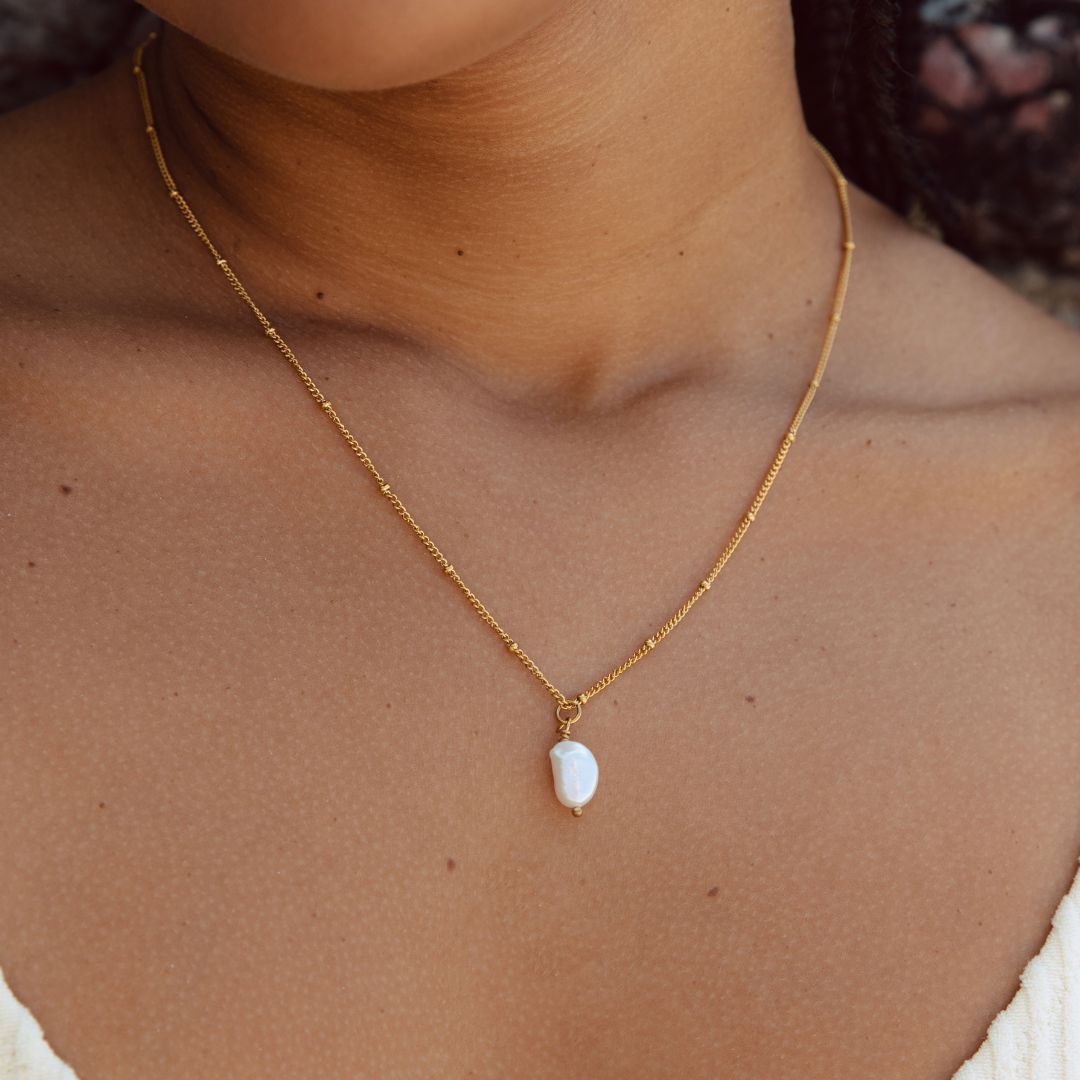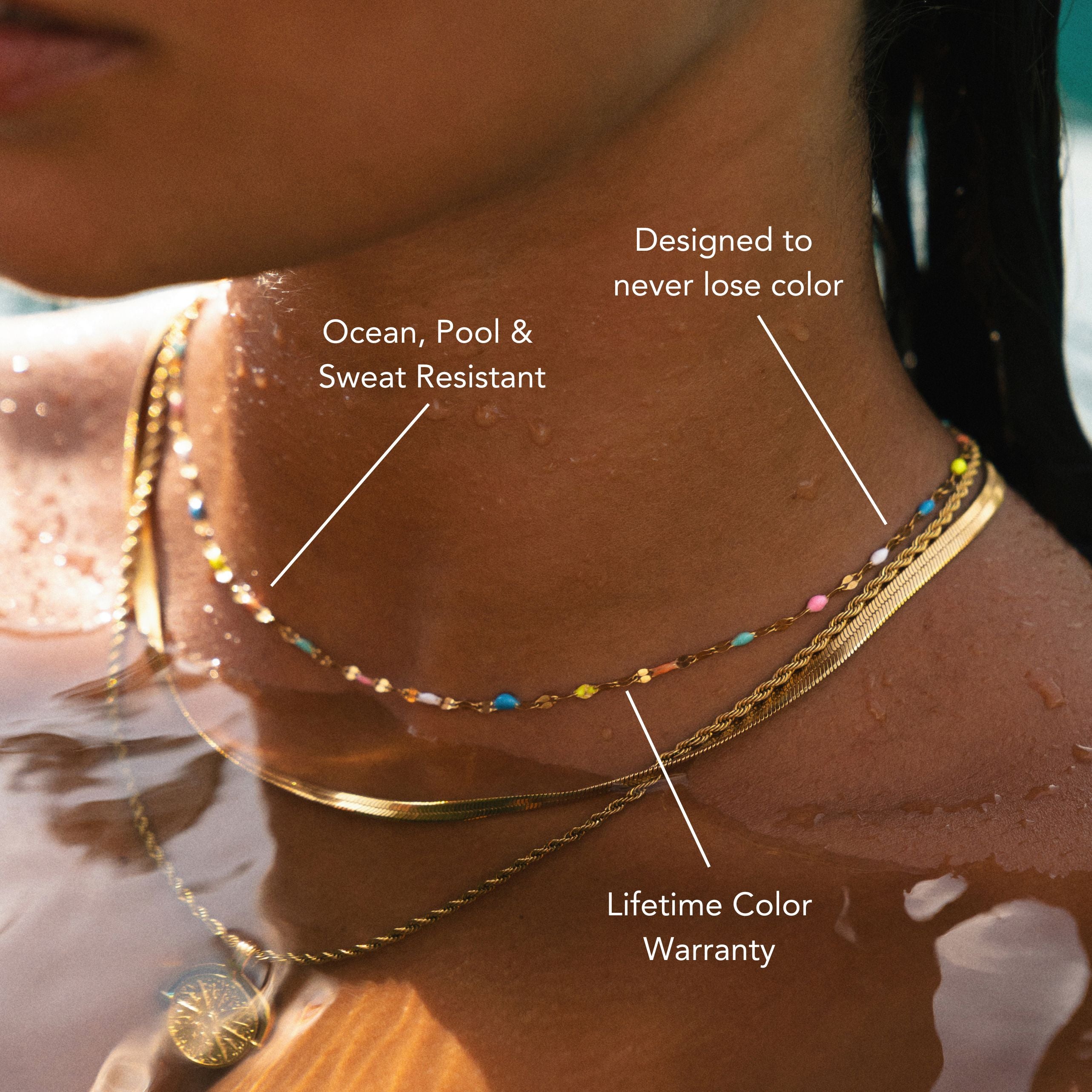
Uncover the Fascinating History of Birthstones
The history of birthstones stretches back over 3,000 years, rooted in ancient civilizations and their profound beliefs. The Babylonians were among the first to establish a twelve-stone sequence, associating each stone with unique spiritual qualities for every month. Religious texts like the Book of Revelation portray gemstones as symbols of divine power. Cultural interpretations also tie birthstones to zodiac signs, shaping modern traditions. Today, birthstones are celebrated as markers of personal identity and emotional connection, flourishing in jewelry design and gift-giving. Explore how the history of birthstones continues to inspire contemporary trends, particularly in waterproof jewelry that combines enduring style with resilience.
Ancient Origins of Birthstones
Throughout history, the concept of birthstones has frequently intertwined with cultural beliefs and practices. You might find it intriguing that ancient traditions often linked specific gemstones to particular months, each believed to hold unique properties.
By examining these ancient customs, you can trace how different cultures utilized gemstones in rituals, believing they could influence health, fortune, and protection.
In early civilizations, such as the Babylonians, a twelve-stone sequence emerged, each stone corresponding to a specific month. This system laid the groundwork for modern birthstone practices.
The Egyptians also embraced gemstone rituals, using stones like turquoise and lapis lazuli to ward off evil spirits and promote healing. These gemstones weren't merely decorative; they were integral to spiritual and daily life.
As you explore these ancient origins, consider how the symbolism of each stone reflects the beliefs and values of its time.
The rich history surrounding these gemstones underscores their significance beyond mere adornment, revealing a profound connection to human experience. Each birthstone carries with it a legacy steeped in tradition, inviting you to appreciate the depth and meaning behind these colorful stones.
Birthstones in Religious Texts
The significance of gemstones extends into religious texts, where they often symbolize spiritual truths and divine attributes. In biblical references, particularly in the Book of Exodus, the High Priest's breastplate features twelve stones, each representing one of the twelve tribes of Israel. This breastplate serves not only as an ornament but as a declaration of the spiritual significance of gemstones in representing a connection to the divine.
Each stone carries its own meaning; for instance, the sapphire symbolizes wisdom, while the emerald signifies hope and renewal. These associations highlight the belief that these gemstones possess inherent properties that can influence spiritual journeys.
In addition, the Book of Revelation mentions the foundations of the New Jerusalem adorned with precious stones, reinforcing the idea that gemstones embody divine perfection and purity.
When examining these texts, you can see how birthstones aren't merely decorative; they hold profound spiritual meanings. They act as conduits for spiritual energies, encouraging believers to reflect on their faith and relationship with the divine.
In this way, gemstones have transcended their physical form, becoming symbols of deeper spiritual truths woven into the fabric of religious tradition.
The Zodiac Connection
Astrologers have long linked birthstones to the zodiac, believing that these gemstones resonate with the energies of specific astrological signs. Each zodiac sign embodies unique personality traits influenced by celestial symbolism, which extends to their associated gemstones.
For example, the fiery Aries, with its boldness and confidence, is often connected to the vibrant diamond, enhancing its dynamic qualities.
These gemstone associations are deeply rooted in astrology myths, where horoscopic connections suggest that wearing a birthstone can amplify your zodiac's positive attributes while mitigating negative ones. Zodiac calendars further illustrate these connections, highlighting the significance of each stone as you navigate through different life phases.
Understanding zodiac compatibility is essential when choosing a birthstone, as certain stones may be more beneficial for specific individuals.
For instance, a nurturing Cancer may find comfort in the soothing properties of the moonstone. Birthstone horoscopes serve as tools for personal insight, guiding you through astrological influences that align with your experiences.
Birthstones Across Cultures
As you explore the significance of birthstones, you'll notice how ancient beliefs shaped their meanings across various cultures.
These gemstones weren't merely ornamental; they held profound spiritual and healing properties in historical contexts.
Today, their cultural significance continues to evolve, reflecting modern values and personal identity.
Ancient Birthstone Beliefs
Rooted in ancient traditions, various cultures have ascribed unique meanings and powers to birthstones, reflecting their beliefs about the connection between gemstones and human experiences.
Ancient symbolism surrounding these stones often linked them to the zodiac, celestial bodies, or significant deities. For instance, in Babylon, the twelve stones of the breastplate worn by high priests corresponded to the twelve zodiac signs, highlighting the intricate relationship between astrological events and personal traits.
Gemstone mythology extends beyond mere decoration; it served as a tool for self-discovery and healing. People believed that each stone possessed specific properties that could influence emotional and physical well-being. For example, garnet was thought to provide protection and enhance energy, while sapphire was associated with wisdom and divine favor.
As you explore these ancient beliefs, consider how they shaped the significance of birthstones in various cultures.
The reverence for these gemstones reveals a deep-seated understanding of their potential impact on life's journey. Consequently, ancient birthstone beliefs not only reflect the cultural heritage of their time but also invite you to contemplate the enduring power of these stones throughout history.
Modern Cultural Significance
While ancient beliefs laid the groundwork for the significance of birthstones, their relevance has evolved dramatically in modern cultures. Today, birthstone symbolism transcends mere decoration, embodying personal identity and emotional resonance.
You might find that these gems are often incorporated into cultural rituals, such as birthday celebrations or special anniversaries, enhancing their meaning and connection to individual experiences.
In many societies, people wear their birthstones as a symbol of protection or luck, believing each gem carries unique energies. For instance, the ruby, associated with July, is seen as a token of passion and liveliness, while the aquamarine of March symbolizes tranquility and clarity.
These stones frequently appear in personalized jewelry, affirming one's birth month as a badge of honor or belonging. Additionally, the practice of gifting birthstones has become increasingly popular, often signifying an emotional bond between giver and receiver.
As you explore the modern significance of birthstones, consider how these cultural rituals and symbols shape your understanding of identity, community, and the personal stories woven into each gem's history.
Evolution of Birthstone Lists
To understand the evolution of birthstone lists, you need to trace their ancient origins, which were often tied to cultural beliefs and practices.
Over time, these lists have varied markedly across different societies, reflecting changing values and customs.
In modern times, you'll notice how contemporary assignments have been standardized, yet still retain unique cultural nuances.
Ancient Origins of Birthstones
The origins of birthstones trace back thousands of years, revealing a fascinating evolution in their significance and selection. Initially, ancient civilizations, such as the Babylonians, linked gemstones to the twelve zodiac signs and the twelve months of the year. This connection underscored their historical significance, as gemstones were believed to influence the destinies of individuals based on their birth month.
Each stone carried unique gemstone symbolism, representing different aspects of life, personality traits, and even health.
As cultures evolved, so did the lists of birthstones. The modern birthstone list, established in the early 20th century, drew heavily from the biblical references found in the Book of Exodus. The twelve stones of the High Priest's breastplate served as a foundation for contemporary practices.
This evolution illustrates how historical significance intertwines with cultural beliefs, shaping the way we perceive gemstones today.
Your understanding of birthstones now expands beyond mere decoration. Each stone is a tapestry of rich symbolism and history, reflecting the beliefs and practices of ancient peoples.
This deeper knowledge enhances your appreciation for the beauty and meaning behind each birthstone.
Cultural Variations Over Time
As the understanding of birthstones evolved, cultural variations emerged that considerably influenced the lists we recognize today. Different regions adapted the concept of birthstones according to their own historical symbolism and beliefs.
For instance, the ancient Romans associated specific stones with the twelve signs of the zodiac, while Jewish tradition linked them to the twelve tribes, each represented by a unique gem in the Breastplate of Aaron.
Over time, you'll notice how regional variations led to distinct interpretations. In the Middle Ages, the practice of associating certain stones with specific months solidified in Europe, but the choices varied remarkably from one country to another.
For example, while the garnet is linked to January in many Western lists, some Eastern traditions might emphasize the rich symbolism of jade for that same month.
These adaptations reflect not only local customs but also the shifting meanings as societies evolved. The historical symbolism attached to each stone often tied into cultural narratives, such as protection, prosperity, or health, illuminating the rich tapestry of human belief.
Therefore, the lists we recognize today are a fascinating blend of regional influences and historical narratives.
Modern Birthstone Assignments
Modern birthstone assignments reflect a culmination of historical traditions and contemporary interpretations, making them relevant for today's society. As you explore these assignments, you'll notice that they've evolved considerably from their ancient roots. Initially, birthstones were linked to the twelve signs of the zodiac, but over time, various cultures adopted their own interpretations, leading to a plethora of listings.
Today, the American National Retail Jewelers Association offers an official list, which includes not only traditional gemstones but also alternative birthstones. These alternatives provide flexibility, allowing individuals to choose stones that resonate more personally or have specific meanings. For instance, while sapphire is the traditional stone for September, lapis lazuli serves as an alternative for those who might prefer its rich blue hue and associated spiritual properties.
Historical interpretations of birthstones have also been revisited, with many modern lists reflecting a blend of ancient beliefs and contemporary preferences. This synthesis highlights the dynamic nature of birthstones, as they adapt to cultural shifts and personal identities, ensuring that they remain meaningful and cherished symbols for people across generations.
Birthstones and Their Meanings
Throughout history, birthstones have been imbued with symbolic meanings, each representing specific traits, emotions, or spiritual qualities. Birthstone symbolism varies markedly across cultures, with each gem corresponding to distinct characteristics. For instance, the fiery garnet, often linked to January, signifies protection and passion. In contrast, the tranquil sapphire, associated with September, embodies wisdom and loyalty.
The historical significance of birthstones traces back to ancient civilizations, where gems were believed to possess divine powers. Egyptians wore lapis lazuli to connect with the heavens, while Romans associated emeralds with fertility and rebirth. These associations reflect not only the stones' aesthetic appeal but also their perceived influence on personal and spiritual well-being.
As you explore each stone's meaning, consider how these attributes resonate with your own identity or aspirations. Whether you're drawn to the nurturing qualities of the moonstone or the courage symbolized by the ruby, understanding birthstone symbolism can deepen your connection to these remarkable gems.
Ultimately, the meanings behind birthstones serve as a reflection of human experiences, intertwining history, culture, and personal significance in ways that continue to inspire today.
Modern Birthstone Traditions
Birthstone traditions have evolved markedly over time, adapting to contemporary cultural practices while maintaining a connection to their historical roots. Today, these gemstones carry modern symbolism that transcends mere aesthetics. You might find that people increasingly associate their birthstones with personal traits, such as strength or creativity, linking them to individual identity.
Additionally, many now embrace gemstone therapy, believing that specific stones harbor healing properties. For instance, amethyst is often thought to promote calmness, while citrine is associated with prosperity. This therapeutic aspect adds a layer of significance, inviting you to explore the emotional and spiritual dimensions of your birthstone.
In modern society, you may notice that birthstones are no longer just reserved for traditional jewelry. They've found their way into wellness practices, meditation tools, and even home decor, reflecting a broader understanding of their value.
As you engage with these stones, consider how they can resonate with your personal journey and aspirations. The fusion of ancient beliefs and contemporary practices creates a rich tapestry of meaning, ensuring that birthstones remain relevant in today's diverse cultural landscape.
Birthstones in Jewelry Design
In recent years, the integration of birthstones into jewelry design has gained significant traction, reflecting both personal significance and artistic expression. You'll find that designers often leverage color symbolism to evoke emotions and convey meanings through their creations. For example, sapphires represent wisdom, while emeralds symbolize renewal. This intentional use of color adds depth to each piece, making it more than just an accessory.
When it comes to practicality, gemstone durability plays a vital role in design choices. Certain stones, like diamonds and rubies, are renowned for their hardness, ensuring longevity in everyday wear. This durability allows you to wear your birthstone jewelry with confidence, knowing it can withstand the rigors of daily life.
Moreover, the adaptability of birthstones enables you to explore various settings and styles. Whether you prefer minimalist designs or elaborate pieces, the incorporation of your birthstone can enhance the aesthetic appeal. Each piece becomes a unique expression of your identity, intertwining personal significance with artistic vision.
Ultimately, the thoughtful combination of color symbolism and gemstone durability makes birthstones a compelling choice in modern jewelry design.
The Future of Birthstones
As you explore the future of birthstones, you'll notice emerging trends in jewelry that prioritize both personal expression and sustainability.
The shift towards sustainable gemstone practices is reshaping how you view these gems, making ethical sourcing a key consideration.
Additionally, personalized birthstone experiences are becoming more prevalent, allowing you to create unique connections with your stones that reflect your individuality.
Emerging Trends in Jewelry
What drives the resurgence of birthstones in contemporary jewelry design? You'll find that it's a blend of personal expression and innovative trends.
Minimalist designs are on the rise, allowing birthstones to shine in their natural beauty without overwhelming embellishments. Meanwhile, statement pieces featuring bold colors attract attention, making them perfect for layering techniques that enhance your overall look.
The vintage revival adds a nostalgic touch, with many opting for stacking rings that celebrate individual birthstones while creating a cohesive aesthetic. These rings often feature custom settings, showcasing artisanal craftsmanship and unique configurations.
In addition to traditional materials, you'll notice an increasing use of eco-friendly materials, aligning with modern consumer values.
Mixed media approaches are also gaining traction, merging various textures and elements to craft distinctive jewelry that tells a story.
As trends evolve, birthstones are being reinterpreted, allowing you to embrace their significance while staying fashionable. Whether you prefer a subtle nod to tradition or a bold statement, the future of birthstones in jewelry design offers endless possibilities for personalization and creativity.
Sustainable Gemstone Practices
With the spotlight shifting towards sustainability, the gemstone industry is undergoing significant transformation to meet ethical standards and consumer demands.
You'll notice a growing emphasis on ethical sourcing, where gemstones are acquired without exploiting labor or harming communities. This shift promotes fair trade practices, ensuring that artisans benefit directly from their craftsmanship.
Eco-friendly materials are becoming more prevalent, with many brands prioritizing sustainable mining techniques that minimize environmental impact. These methods focus on reducing waste and preserving ecosystems, aligning with the principles of responsible sourcing.
Furthermore, gemstone recycling is gaining traction, allowing you to enjoy beautiful pieces while contributing to a circular economy.
Artisanal craftsmanship plays an essential role in this movement, as skilled artisans create unique designs using renewable resources. This approach fosters community engagement, empowering local populations and preserving traditional techniques.
By supporting these practices, you're not just purchasing jewelry; you're investing in a sustainable future.
As the industry evolves, you'll find that the demand for transparency and accountability in gemstone sourcing continues to grow, ensuring that your choices reflect your values in a world increasingly conscious of its environmental footprint.
Personalized Birthstone Experiences
The focus on sustainability in the gemstone industry is paving the way for personalized birthstone experiences that resonate with individual values and preferences. As you explore personalized jewelry options, you'll find that custom designs allow you to create unique gifts that reflect your identity or cherished relationships.
By incorporating birthstone symbolism, these pieces gain emotional significance, turning them into more than just adornments. Imagine crafting a piece that tells your family's story, using gemstones that represent milestones or shared memories. Each birthstone can serve as a reminder of meaningful connections, creating a narrative woven through your jewelry.
These custom designs can evolve into family heirlooms, passed down through generations, preserving personal stories that define your lineage. As you navigate this personalized approach, consider how each stone's emotional significance enhances the experience.
Whether it's a necklace, ring, or bracelet, the combination of sustainability and personalization guarantees that your jewelry not only looks stunning but also aligns with your values. By embracing these personalized birthstone experiences, you're not just wearing jewelry; you're celebrating your story, your legacy, and the meaningful connections that shape your life.
Frequently Asked Questions
How Do Birthstones Differ From Traditional Gemstones?
Birthstones differ from traditional gemstones primarily in their historical significance and cultural associations. While gemstones possess unique physical properties, birthstones are imbued with meanings linked to specific months, enhancing their value beyond mere aesthetics.
Are There Any Birthstones Associated With Specific Months Outside the Modern List?
Yes, certain historical associations and ancient beliefs link additional stones to specific months. For instance, ancient cultures often recognized different gems like turquoise for December, reflecting unique significance beyond the modern birthstone list you might know.
Can Birthstones Have Different Meanings in Various Cultures?
Yes, birthstones can have different meanings across cultures. Their cultural significance often leads to various symbolic interpretations, reflecting unique beliefs, traditions, and values, which can influence how individuals perceive and connect with these stones.
Is It Possible to Wear Multiple Birthstones at Once?
Yes, you can wear multiple birthstone combinations. Many enjoy this practice for its aesthetic appeal and cultural significance variations. Each stone can symbolize different traits or energies, enriching your personal expression and connection to those meanings.
How Can I Choose a Birthstone as a Gift for Someone?
To choose a birthstone as a gift, consider the recipient's birth month and the stone's symbolic meaning. A personalized gift reflects their personality, making it more meaningful and cherished, enhancing both aesthetic and emotional value.
Conclusion
As you explore the fascinating history of birthstones, you'll uncover their rich origins and cultural significance. These gems have evolved from ancient traditions into modern symbols of identity and personal connection. You may notice how birthstones influence jewelry design and trends, reflecting individual styles and preferences. With their enduring appeal, birthstones will likely continue to inspire future generations. Their blend of beauty, meaning, and history guarantees that they hold a special place in both our lives and our hearts.
























Leave a comment
This site is protected by hCaptcha and the hCaptcha Privacy Policy and Terms of Service apply.